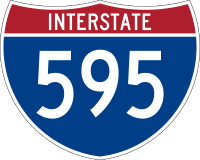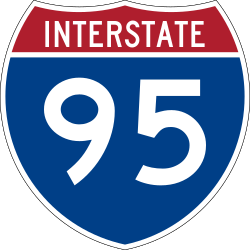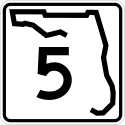Interstate 595 (Florida)
 | |
| Basisdaten | |
|---|---|
| Länge: | 12.860 mi/20.696 km |
| Bundesstaat: | Florida |
Die Interstate 595 (kurz I-595) ist ein Interstate Highway, der innerhalb des Broward County im US-Bundesstaat Florida auf einer Länge von gut 20 km von Sunrise zum Port Everglades verläuft. Die Straße ist mit der Florida State Road 862 deckungsgleich und ist lokal auch als Port Everglades Expressway bekannt.
Streckenverlauf
Die Interstate beginnt bei Sunrise, wo sie an einem Autobahnkreuz von der Interstate 75 und der State Road 869 abzweigt. Anschließend führt sie mit mehreren Auf- und Abfahrten parallel zur State Road 84, bevor sie nacheinander die State Road 817, den Florida’s Turnpike, den U.S. Highway 441/State Road 7 sowie die Interstate 95 kreuzt. Schließlich endet sie beim Port Everglades südlich von Fort Lauderdale bzw. nördlich des Fort Lauderdale-Hollywood International Airport.
Geschichte
In der Planungsphase in den frühen 1980er Jahren war die Interstate als mautpflichtige Straße vorgesehen, um die Baukosten zügig zu decken. Diese Pläne wurden bis zur Inbetriebnahme jedoch wieder verworfen. Ein westliches Teilstück wurde Mai 1988, ein östliches Teilstück am 24. Februar 1989 und das mittlere Teilstück schließlich am 21. Oktober 1989 dem Verkehr übergeben. Am 11. Juni 1990 wurde die Straße als Interstate 595 benannt und am 22. März 1991 wurde die Rainbow Interchange mit der Interstate 95 fertiggestellt.[1]
Weblinks
Einzelnachweise
- ↑ History of Interstate 595 (Memento vom 12. Oktober 2004 im Internet Archive)
Auf dieser Seite verwendete Medien
24 in by 24 in (600 mm by 600 mm) Florida State Road shield, made to the specifications of the sign detail. Uses the Roadgeek 2005 fonts. (United States law does not permit the copyrighting of typeface designs, and the fonts are meant to be copies of a U.S. Government-produced work anyway.) The outside border has a width of 1 (1/16 in) and a color of black so it shows up; in reality, signs have no outside border. Note that the drawing does not provide the border width or curve radii. (The previous page does but seems very inaccurate.) Thus those measurements are approximated from the drawing. The state outline is extracted from the PDF and cleaned up (to make the inside match the outside).
30 in by 24 in (750 mm by 600 mm) Florida State Road shield, made to the specifications of the sign detail. Uses the Roadgeek 2005 fonts. (United States law does not permit the copyrighting of typeface designs, and the fonts are meant to be copies of a U.S. Government-produced work anyway.) The outside border has a width of 1 (1/16 in) and a color of black so it shows up; in reality, signs have no outside border. Note that the drawing does not provide the border width or curve radii. (The previous page does but seems very inaccurate.) Thus those measurements are approximated from the drawing. The state outline is extracted from the PDF and cleaned up (to make the inside match the outside).
24 in by 24 in (600 mm by 600 mm) Florida State Road shield, made to the specifications of the sign detail. Uses the Roadgeek 2005 fonts. (United States law does not permit the copyrighting of typeface designs, and the fonts are meant to be copies of a U.S. Government-produced work anyway.) The outside border has a width of 1 (1/16 in) and a color of black so it shows up; in reality, signs have no outside border. Note that the drawing does not provide the border width or curve radii. (The previous page does but seems very inaccurate.) Thus those measurements are approximated from the drawing. The state outline is extracted from the PDF and cleaned up (to make the inside match the outside).
30 in by 24 in (750 mm by 600 mm) Florida State Road shield, made to the specifications of the sign detail. Uses the Roadgeek 2005 fonts. (United States law does not permit the copyrighting of typeface designs, and the fonts are meant to be copies of a U.S. Government-produced work anyway.) The outside border has a width of 1 (1/16 in) and a color of black so it shows up; in reality, signs have no outside border. Note that the drawing does not provide the border width or curve radii. (The previous page does but seems very inaccurate.) Thus those measurements are approximated from the drawing. The state outline is extracted from the PDF and cleaned up (to make the inside match the outside).
30 in by 24 in (750 mm by 600 mm) Florida State Road shield, made to the specifications of the sign detail. Uses the Roadgeek 2005 fonts. (United States law does not permit the copyrighting of typeface designs, and the fonts are meant to be copies of a U.S. Government-produced work anyway.) The outside border has a width of 1 (1/16 in) and a color of black so it shows up; in reality, signs have no outside border. Note that the drawing does not provide the border width or curve radii. (The previous page does but seems very inaccurate.) Thus those measurements are approximated from the drawing. The state outline is extracted from the PDF and cleaned up (to make the inside match the outside).
600 mm × 600 mm (24 in × 24 in) U.S. Highway shield, made to the specifications of the 2004 edition of Standard Highway Signs. (Note that there is a missing "J" label on the left side of the diagram.) Uses the Roadgeek 2005 fonts. (United States law does not permit the copyrighting of typeface designs, and the fonts are meant to be copies of a U.S. Government-produced work anyway.)
24 in by 24 in (600 mm by 600 mm) Florida State Road shield, made to the specifications of the sign detail. Uses the Roadgeek 2005 fonts. (United States law does not permit the copyrighting of typeface designs, and the fonts are meant to be copies of a U.S. Government-produced work anyway.) The outside border has a width of 1 (1/16 in) and a color of black so it shows up; in reality, signs have no outside border. Note that the drawing does not provide the border width or curve radii. (The previous page does but seems very inaccurate.) Thus those measurements are approximated from the drawing. The state outline is extracted from the PDF and cleaned up (to make the inside match the outside).
600 mm by 600 mm (24 in by 24 in) Interstate shield, made to the specifications of the 2004 edition of Standard Highway Signs (sign M1-1). Uses the Roadgeek 2005 fonts. (United States law does not permit the copyrighting of typeface designs, and the fonts are meant to be copies of a U.S. Government-produced work anyway.) Colors are from [1] (Pantone Red 187 and Blue 294), converted to RGB by [2]. The outside border has a width of 1 (1 mm) and a color of black so it shows up; in reality, signs have no outside border.
750 mm × 600 mm (30 in × 24 in) U.S. Highway shield, made to the specifications of the 2004 edition of Standard Highway Signs. (Note that there is a missing "J" label on the left side of the diagram.) Uses the Roadgeek 2005 fonts. (United States law does not permit the copyrighting of typeface designs, and the fonts are meant to be copies of a U.S. Government-produced work anyway.)
24 in by 24 in (600 mm by 600 mm) Florida State Road shield, made to the specifications of the sign detail. Uses the Roadgeek 2005 fonts. (United States law does not permit the copyrighting of typeface designs, and the fonts are meant to be copies of a U.S. Government-produced work anyway.) The outside border has a width of 1 (1/16 in) and a color of black so it shows up; in reality, signs have no outside border. Note that the drawing does not provide the border width or curve radii. (The previous page does but seems very inaccurate.) Thus those measurements are approximated from the drawing. The state outline is extracted from the PDF and cleaned up (to make the inside match the outside).













